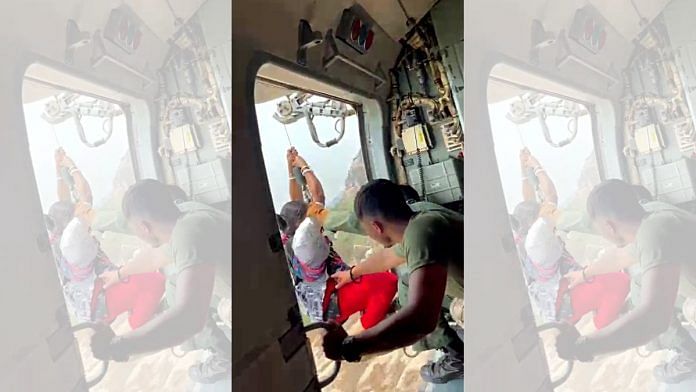New Delhi: Gushing winds, parallel cables that could get entangled, unstable cable cars suspended 400 feet from the ground, and a narrow gorge — this is what turned the rescue operation at the Trikut Hills in Deoghar, Jharkhand, into a “most challenging” mission that took more than 44 hours, according to officials involved.
Twenty ropeway cable cars halted mid-air Sunday around 3.30 pm after a malfunction, leaving more than 76 people trapped. Three people were killed in separate incidents — one when a trolley fell to the ground, and two during the rescue operation.
On Sunday, the National Disaster Response Force (NDRF) and the local administration were able to rescue 28 people manually from eight trolleys that were at a lower height, with the help of local people and guides. But others remained trapped in 12 trolleys.
This necessitated an operation that involved five Indian Air Force (IAF) choppers — two Mi-17V-5, one Mi-17, one Advanced Light Helicopter (ALH) and one Cheetah — which flew for over 26 hours, with a team of 200 personnel from the Indo-Tibetan Border Police (ITBP), NDRF, the Army and state forces, besides the IAF.
Starting Monday morning, 34 more people were rescued through the day from seven cable cars.
Thirteen more people were finally rescued from the remaining five cable cars Tuesday, and the operation came to an end by 4 pm.
“It was a very complex operation. While some trolleys were suspended at 250-300 feet, some were at 400 feet amid boulders, rocks in a gorge — which is a narrow valley. It was impossible to reach them from the ground, and that is why the Air Force choppers had to be brought in,” a senior NDRF officer who led the operation told ThePrint.
“We followed a two-way approach. One was vertical — rescue from above using the choppers — and the other horizontal, from the ground. But the velocity of the wind was so high, it was making the person being evacuated from the trolley swing ferociously,” the officer said.
“We had to ensure that the person being evacuated didn’t get entangled in the cables of the ropeway, and that’s why it was an additional challenge,” he added.
During this process, neither the choppers nor the trolleys remained still, ITBP spokesperson Vivek Kumar Pandey told ThePrint.
“The people were also very scared, because whoever got out of the trolley was swinging badly and feared colliding and getting entangled with the cable wires, which was a big hindrance and a challenge,” he said.
Also read: Drones, mountaineers, rock climbers: How Army rescued amateur trekker trapped on Kerala hill
‘A daunting task’
A statement released by the Indian Air Force (IAF) said the rescue contingent included five IAF Garud commandos, who had the “daunting task” of climbing onto the stranded trolleys while attached to a helicopter’s winch cable. Accessing the trolleys from outside, they had to strap up each survivor individually and get them winched up and into the helicopter hovering overhead.
“Smaller children were carried up to the helicopter by the Garuds themselves. The helicopter crew was faced with their own challenges where they had to maintain a steady hover, with practically no visual reference, in conditions of strong winds in the hilly terrain,” the statement said.
“The crew went from one trolley to the next to carry out their task, which was as risky for the crew as it was for the survivors of the mishap,” it added.
The operation, spread over two days, also saw two unfortunate incidents where, despite the forces’ best efforts, “the survivors could not be rescued safely due to the inherently difficult nature of the rescue operation”, the statement said.
The ‘long difficult nights’
Through the nights Sunday and Monday, personnel climbed onto a two-foot-wide plank — used as a ‘maintenance trolley’ by the ropeway company — and reached out to the stranded people to assure them that they would be extracted safely. Moreover, food packets and water bottles were also thrown inside the trolleys.
“This plank was on a parallel ropeway, and there was a distance of at least 20 metres between it and the stranded trolleys,” Deoghar Deputy Commissioner Manjunath Bhajantri told ThePrint.
The plank, however, was unable to reach some trolleys that were stuck further ahead at a greater height. “It is a long ropeway, almost 770 metres. While some trolleys were near the starting point and could be reached with the help of the maintenance trolley, others were at a distance, towards the end point of the ropeway — and since it was a steep cliff, they were not reachable,” said Bhajantri.
Announcements asking the people to be calm were being made through the nights, he added.
“Arrangements were made for sufficient light. We also tried to use drones to ensure that packets reached people, but it was not much of a success, since the trolleys are enclosed boxes and dropping off packets was not working,” he said.
A senior state government officer also said that although it appeared that the accident occurred when an “axle was dislodged and the rope in one pulley came on to the other” — leading to a jerk, and suspension of the trolleys — the cause of the incident is being probed.
“An inquiry into the incident is on. We will know exactly what went wrong once it is completed,” he said.
(Edited by Rohan Manoj)
Also read: ‘Ropeway was shaking violently, people were screaming’: Paharia tribal who rescued eight tourists



